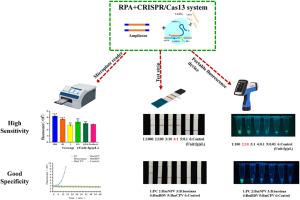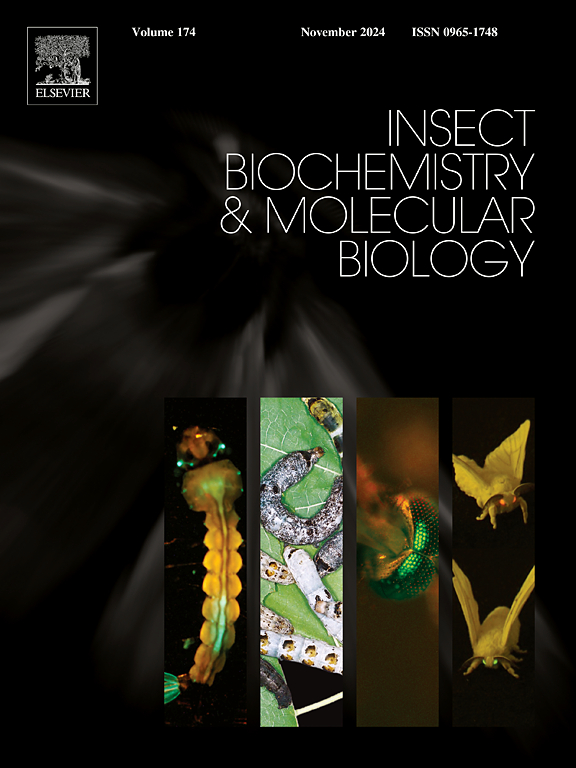CRISPR/Cas13a-mediated visual detection: A rapid and robust method for early detection of Nosema bombycis in silkworms
IF 3.2
2区 农林科学
Q2 BIOCHEMISTRY & MOLECULAR BIOLOGY
引用次数: 0
Abstract
The sericulture industry faces a significant threat from the Pebrine disease of silkworms, caused by Nosema bombycis. Nonetheless, the current microscopic diagnostic methods can be time-consuming, labor-intensive, and lacking sensitivity and accuracy. Therefore, it is crucial to develop a novel detection approach that is efficient, highly sensitive, and low-cost. In this regard, the CRISPR/Cas system has the potential to be a fast, accurate, and highly specific method of detection. Herein, using a microplate reader, a portable fluorescence detection device, and test strips as signal output tools respectively, we have efficiently developed three rapid and facile visual detection methods for N. bombycis using a CRISPR/Cas13a system with conjugation of Recombinase polymerase amplification (RPA). We evaluated the sensitivity of this combined technology by comparing it with the positive plasmid standard and the genome standard of N. bombycis. Remarkably, the sensitivity of the CRISPR/Cas13a system for N. bombycis positive plasmid standard based on the microplate reader, portable fluorescence detection device, and test strips was 1 copy/μL, 10 copies/μL, and 1 copy/μL, respectively, while for the N. bombycis genome standards, the detection sensitivity was 10 fg/μL, 10 fg/μL, and 1 fg/μL, respectively. In addition, extensive evaluations have demonstrated that the established technology can accurately detect N. bombycis without cross-reactivity with other pathogens, ensuring a specificity rate of 100%. In brief, this study will provide a practical, efficient, and affordable method for early and rapid detection of N. bombycis in various settings.

CRISPR/Cas13a 介导的视觉检测:一种早期检测家蚕诺斯玛病的快速而可靠的方法。
养蚕业面临着由诺瑟玛蝇(Nosema bombycis)引起的家蚕白绢病的巨大威胁。然而,目前的显微诊断方法耗时、耗力,而且缺乏灵敏度和准确性。因此,开发一种高效、高灵敏度、低成本的新型检测方法至关重要。在这方面,CRISPR/Cas 系统有可能成为一种快速、准确和高度特异性的检测方法。在本文中,我们分别使用微孔板阅读器、便携式荧光检测设备和试纸作为信号输出工具,利用 CRISPR/Cas13a 系统和重组酶聚合酶扩增(RPA),有效地开发了三种快速简便的 N. bombycis 视觉检测方法。我们通过与 N. bombycis 的阳性质粒标准和基因组标准进行比较,评估了这一组合技术的灵敏度。值得注意的是,基于微孔板阅读器、便携式荧光检测装置和测试条的 CRISPR/Cas13a 系统对 N. bombycis 阳性质粒标准的灵敏度分别为 1 拷贝/μL、10 拷贝/μL 和 1 拷贝/μL,而对 N. bombycis 基因组标准的检测灵敏度分别为 10 fg/μL、10 fg/μL 和 1 fg/μL。此外,大量评估结果表明,所建立的技术能准确检测出 N. bombycis,不会与其他病原体产生交叉反应,确保特异性达到 100%。简而言之,这项研究将为在各种环境中早期快速检测 N. bombycis 提供一种实用、高效且经济实惠的方法。
本文章由计算机程序翻译,如有差异,请以英文原文为准。
求助全文
约1分钟内获得全文
求助全文
来源期刊
CiteScore
7.40
自引率
5.30%
发文量
105
审稿时长
40 days
期刊介绍:
This international journal publishes original contributions and mini-reviews in the fields of insect biochemistry and insect molecular biology. Main areas of interest are neurochemistry, hormone and pheromone biochemistry, enzymes and metabolism, hormone action and gene regulation, gene characterization and structure, pharmacology, immunology and cell and tissue culture. Papers on the biochemistry and molecular biology of other groups of arthropods are published if of general interest to the readership. Technique papers will be considered for publication if they significantly advance the field of insect biochemistry and molecular biology in the opinion of the Editors and Editorial Board.

 求助内容:
求助内容: 应助结果提醒方式:
应助结果提醒方式:


